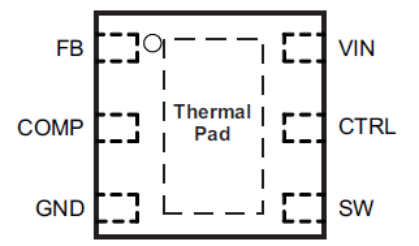JAJS402C March 2009 – July 2016 TPS61160A , TPS61161A
PRODUCTION DATA.
- 1 特長
- 2 アプリケーション
- 3 概要
- 4 改訂履歴
- 5 Pin Configuration and Functions
- 6 Specifications
- 7 Detailed Description
- 8 Application and Implementation
- 9 Power Supply Recommendations
- 10Layout
- 11デバイスおよびドキュメントのサポート
- 12メカニカル、パッケージ、および注文情報
パッケージ・オプション
メカニカル・データ(パッケージ|ピン)
- DRV|6
サーマルパッド・メカニカル・データ
- DRV|6
発注情報
5 Pin Configuration and Functions
DRV Package
6-Pin WSON With Thermal Pad
Top View

Pin Functions
| PIN | I/O | DESCRIPTION | |
|---|---|---|---|
| NAME | NO. | ||
| COMP | 2 | O | Output of the transconductance error amplifier. Connect an external capacitor to this pin to compensate the regulator. |
| CTRL | 5 | I | Control pin of the boost regulator. Enable and disable device. PWM signal can be applied to the pin for LED brightness dimming as well. |
| FB | 1 | I | Feedback pin for current. Connect the sense resistor from FB to GND. |
| GND | 3 | O | Ground |
| SW | 4 | I | This is the switching node of the IC. Connect the inductor between the VIN and SW pin. This pin is also used to sense the output voltage for open LED protection |
| VIN | 6 | I | The input supply pin for the IC. Connect VIN to a supply voltage between 2.7 V and 18 V. |
| Thermal Pad | The thermal pad should be soldered to the analog ground plane. If possible, use thermal via to connect to ground plane for ideal power dissipation. | ||